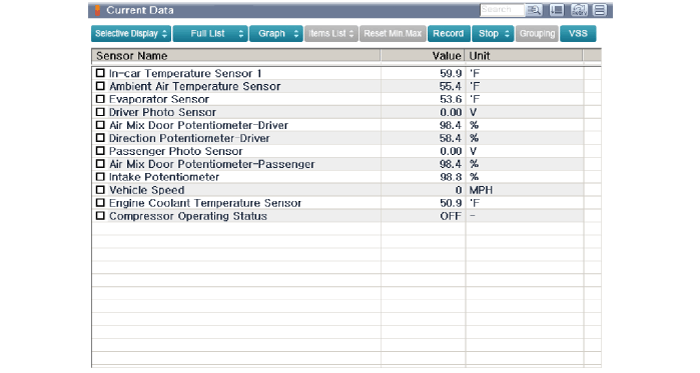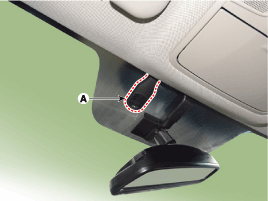Hyundai Elantra: Air Conditioning System / Auto Defogging Sensor Repair procedures
| Diagnosis With GDS |
| 1. |
The heating, ventilation and air conditioning can be quickly diagnosed failed parts with vehicle diagnostic system (GDS).
? The diagnostic system (GDS) provides the following information.
(1) Self diagnosis : Checking the failure code (DTC) and display.
(2) Current data : Checking the system input / output data state.
(3) Actuation test : Checking the system operation condition.
(4) Additional function : Other controlling such as he system option and zero point adjustment. |
| 2. |
Select the 'Car model' and the system to be checked in order to check the vehicle with the tester. |
| 3. |
Select the 'Current data' menu to search the current state of the input / output data.
The input / output data for the sensors corresponding to the Auto Defogging Sensor can be checked.
|
| Replacement |
| 1. |
Disconnect the negative (-) battery terminal. |
| 2. |
Remove the auto defogging cover (A).
|
| 3. |
Disconnect the connector (A) and then remove the auto defogging sensor (B).
|
| 4. |
To intall, reverse the removal procedure. |
 Auto Defogging Sensor Description and Operation
Auto Defogging Sensor Description and Operation
Description
The auto defogging sensor is installed on the front window
glass. The sensor judges and sends signal if moisture occurs to blow out
wind for defogging. The air conditioner control m ...
 Cluster Ionizer Components and Components Location
Cluster Ionizer Components and Components Location
Components Location
1. Cluster Ionizer
...
Other information:
Hyundai Elantra AD (2016-2020) Service Manual: 35R Clutch Control Solenoid Valve(35R/C_VFS) Specifications
Specifications
ShapeItems Specifications Control current(voltage) [mA] 0 ~ 1100 Supply pressure [kpa (kgf/cm?, psi)] 1569.06 (16, 227.57) Control pressure [kpa (kgf/cm?, psi)] 0 ~ 1569.06 (0 ~ 16, 0 ~ 227.57) Internal resistance(?) 5.0 ~ 5.6
...
Hyundai Elantra AD (2016-2020) Service Manual: Components and Components Location
Components
The following is the configuration of the AEB system.
-
Detection device (radar and camera) that can recognize potential obstacles in the front.
-
Human-Machine Interface (HMI) to warn driver or change settings.
-
Braking system to automatically brake the car
AEB, contr ...



